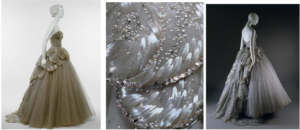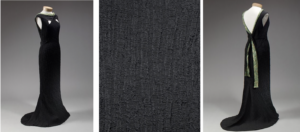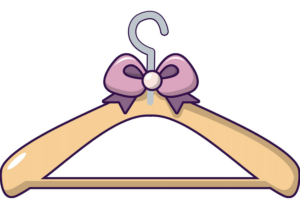Midterm Progress:
For my midterm project, I’m taking on the challenge of designing a captivating costume exhibit for The MET’s Costume Institute. The exhibit will showcase the evolution of haute couture through iconic designs from renowned fashion houses, spanning different eras and design philosophies.
The overarching theme of the exhibit is “Timeless Elegance: A Journey Through Fashion History.” My aim is to highlight the enduring allure and innovation of haute couture, exploring how designers have redefined beauty and style over the decades.
1. Homepage:
– The homepage welcomes visitors to the online exhibit with a visually appealing layout featuring the exhibit’s title, a brief description, and navigation options.
2. Navigation Menu:
– A navigation menu at the top or side of the webpage allows visitors to easily access different sections of the exhibit, including:
– Explore: Provides access to the main exhibit layout where visitors can view featured designers and garments.
– Audio Guides: Offers a collection of audio commentary on select pieces.
– Search: Enables visitors to search for specific designers, garments, or fashion movements.
– About: Provides information about the exhibit, its curators, and contributors.
3. Explore Section:
– Clicking on the “Explore” option takes visitors to the main exhibit layout, which may resemble a gallery or virtual space.
– Visitors can navigate through different areas of the exhibit by clicking or tapping on designated hotspots or arrows.
– Clicking on a designer’s name or garment reveals detailed information, including descriptions, historical context, and images.
4. Audio Guides:
– The “Audio Guides” section presents visitors with a curated collection of audio commentary on select pieces within the exhibit.
– Visitors can listen to the audio commentary by clicking on specific garments or audio icons associated with them.
5. Search Functionality:
– The “Search” option allows visitors to search for specific designers, garments, or fashion movements.
– Visitors can enter keywords or phrases into the search bar to find relevant content within the exhibit.
– Search results display relevant garments, designers, or topics, with clickable links to access more information.
Interactive Elements:
– Throughout the exhibit, interactive elements such as clickable images, videos, and multimedia presentations provide additional context and engagement.
– Visitors can interact with these elements by clicking or tapping on them to access related content or animations.
Some examples:
7. Responsive Design:
– The online exhibit is designed to be responsive, ensuring a seamless experience across different devices and screen sizes.
– Whether visitors access the exhibit on a desktop computer, tablet, or smartphone, the layout and functionality adapt to provide an optimal viewing experience.
- Maintaining Engagement: Keeping visitors engaged throughout their online exhibit experience is crucial. Unlike in-person exhibits where visitors may spend hours exploring, online visitors may have shorter attention spans. Designing captivating visuals, interactive elements, and compelling content is essential to maintain visitor interest and encourage exploration.
- Audio and Video Integration: Integrating audio and video content into the exhibit may present challenges such as ensuring cross-browser compatibility, synchronizing multimedia elements with other interactive elements or animations, and optimizing playback performance for smooth audio/video streaming.
let titleSize = 40; // Decreased the title size
let subtitleSize = 20; // Decreased the subtitle size
function preload(){
hangerImage = loadImage('Hanger.png'); // Load hanger image }
}
function setup() {
createCanvas(windowWidth, windowHeight);
textSize(titleSize);
textAlign(CENTER, CENTER);
}
function draw() { background(255); // Set background color to white
if (mouseIsPressed || mouseX != pmouseX || mouseY != pmouseY) {
// Display hanger image on mouse hover
image(hangerImage, mouseX, mouseY, 70, 50);
}
// Title
fill(166, 0, 0); // Set text color to red
textSize(titleSize);
text("Welcome to Timeless Elegance", width / 2, height / 2 - 50);
// Subtitle
fill(0); // Set text color to red
textSize(subtitleSize);
text("Touch the screen to begin your journey", width / 2, height / 2 + 20);
}
function mouseClicked() {
// Trigger next screen or action when the screen is touched/clicked
// For example, navigate to the main exhibit layout
}
The hanger icon serves as a visual representation of fashion and garment design, reinforcing the theme of the exhibit. It symbolizes the process of selecting, showcasing, and appreciating designer garments, further immersing visitors in the world of fashion.Changing the mouse cursor to a hanger creates a more immersive experience for visitors, immediately signaling that they are entering a fashion-themed environment. This subtle visual cue helps transport visitors into the world of haute couture and sets the tone for the exhibit.
https://docs.google.com/document/d/1wQb92P4HcfuLNuzHEYyvs3ZUFQNo6hspwGtPbJLv53Q/edit?usp=sharing (More details about the costume institute and what dress will be included in the exhibit)
Reading response:
The reading on “Computer Vision for Artists and Designers” delves into the increasing accessibility of computer vision technology to artists and designers, facilitated by user-friendly software and open-source communities. It showcases various projects, including Rafael Lozano-Hemmer’s intriguing installation “Standards and Double Standards” (2004), where belts controlled by a computer vision-based tracking system rotate to follow individuals, offering an unintentional yet captivating form of interaction.
However, the ethical implications become pronounced with projects like Suicide Box by the Bureau of Inverse Technology (1996), which utilized motion-detection to record real data of suicides, raising concerns about privacy and surveillance. While such data might aid in locating missing individuals, it blurs ethical boundaries, sparking controversy.
Moreover, the reading outlines different problems addressed by vision algorithms, such as motion detection and object tracking, underscoring their relevance in design considerations. The introduction of “Telecentric lenses” offers insights into improving object recognition, albeit with drawbacks like cost and distortion issues, prompting reflection on their judicious usage.
The discussion expands to the societal acceptance of constant surveillance through technologies like facial recognition, prompting introspection on privacy norms. This leads to questioning the boundaries between innovation and intrusion, highlighting the need for ethical frameworks in technology adoption.
In reflecting on the reading, two artworks stand out for their distinct approaches to computer vision. Rafael Lorenzo-Hemmer’s “Standards and Double Standards” impresses with its inventive use of space and objects, blurring the lines between digital and tangible realms. In contrast, Christopher Moller’s “Cheese” raises questions about the advancements in facial recognition technology and its potential implications for art and society.






